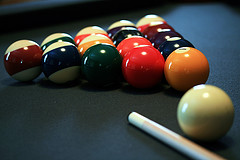
flic.kr/p/3rCr4x
The game of 14.1 Continuous is billiards response to basketball’s HORSE. The player with the turn to take a shot is needed to call out a potential pocket and making that pocket gives the player one point. The player who makes a shot can carry on to take shots until his nominated shot misses the desired pocket. After pocketing the first 14 balls, the player can then attempt to pocket number fifteen after re-racking.
Games of 14.1 continuous billiards usually award one point per predicted pocket shot and games are played until 150 points are attained. Since this could take several games to reach this point , most competitors will agree on a set point total to reach for victory to be declared. Points can be deducted against a player’s total for fouling by not pocketing the desired ball or contacting two balls against the cushion and sending them into the area of play.
While the player must make the shot that he/she announced prior to the shot to get a point, he/she will also be awarded points for each additional ball that is pocketed as a result of the shot. All the player trying the shot must do is declare the ball and pocket that is to be involved on the shot, all caroms or kisses, etc. are irrelevant to the player’s score.
Simply put, the only thing that really matters is for the declared ball to go into the declared pocket.
One of the most confusing aspects of 14.1 continuous billiards is what happens when the first 14 balls are pocketed? The fifteenth ball is left in the same position it is in when the fourteenth was pocketed while the other 14 balls are re-racked with a vacancy where the fifteenth would have been. The shooter can then choose to attempt to pocket the fifteenth ball at that time or just continue to shoot the other 14 until the fifteenth ball is in an ideal spot.
 |
Proven Techniques That Are Guaranteed to Turn Good Players Into Great |
Lastly, a player who continually fouls and doesn’t pocket a shot does go into the negative side of points. Theoretically, therefore, a player could lose a game by the agreed upon score being scored by the winning player and the losing player remaining in the negative side of the points column.
Tagged with: billiards game • billiards history
Filed under: Billiards